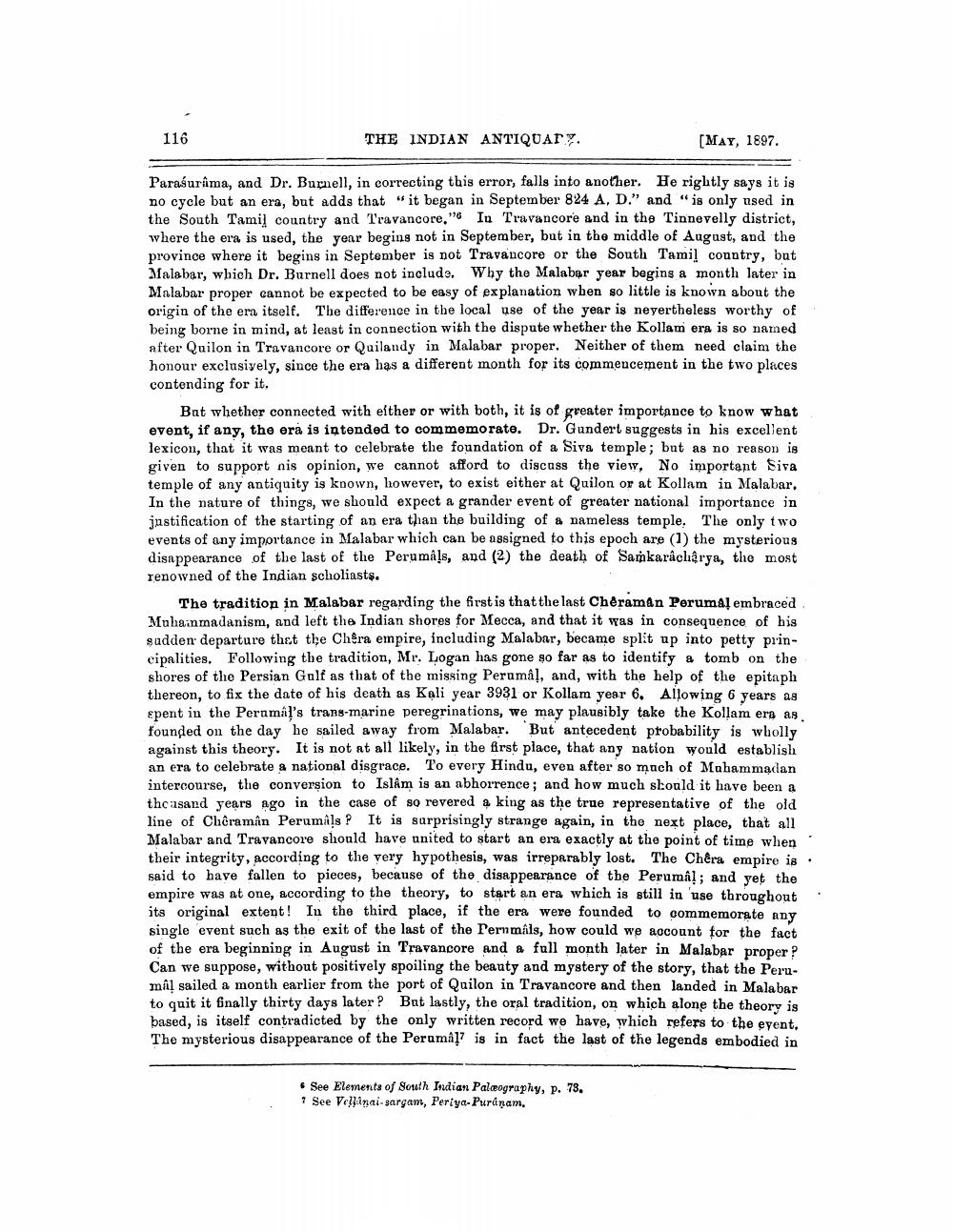________________
116
THE INDIAN ANTIQUAT 7.
[MAY, 1897.
Parasurama, and Dr. Burnell, in correcting this error, falls into another. He rightly says it is no cycle but an era, but adds that "it began in September 824 A, D." and "is only used in the South Tamil country and Travancore." Iu Travancore and in the Tinnevelly district, where the era is used, the year beging not in September, but in the middle of August, and the province where it begins in September is not Travancore or the South Tamil country, but Malabar, which Dr. Burnell does not include. Why the Malabar year begins a month later in Malabar proper cannot be expected to be easy of explanation when so little is known about the origin of the era itself. The difference in the local use of the year is nevertheless worthy of being borne in mind, at least in connection with the dispute whether the Kollam era is so named after Quilon in Travancore or Quilandy in Malabar proper. Neither of them need claim the honour exclusively, since the era has a different month for its commencement in the two places contending for it.
Bat whether connected with either or with both, it is of greater importance to know what event, if any, the era is intended to commemorate. Dr. Gundert suggests in his excellent lexicon, that it was meant to celebrate the foundation of a Siva temple; but as no reason is given to support nis opinion, we cannot afford to discuss the view, No important Siva temple of any antiquity is known, however, to exist either at Quilon or at Kollam in Malabar, In the nature of things, we should expect a grander event of greater national importance in justification of the starting of an era than the building of a nameless temple. The only two events of any importance in Malabar which can be assigned to this epoch are (1) the mysterious disappearance of the last of the Perumals, and (2) the death of Samkaracharya, the most renowned of the Indian scholiasts.
The tradition in Malabar regarding the first is that the last Chéraman Perumal embraced Muhainmadanism, and left the Indian shores for Mecca, and that it was in consequence of his sudden departure thet the Chera empire, including Malabar, became split up into petty principalities. Following the tradition, Mr. Logan has gone so far as to identify a tomb on the shores of the Persian Gulf as that of the missing Peru må!, and, with the help of the epitaph thereon, to fix the date of his death as Kali year 3931 or Kollam year 6. Allowing 6 years as epent in the Peramal's trans-marine peregrinations, we may plausibly take the Kollam era as founded on the day he sailed away from Malabar. But antecedent probability is wholly against this theory. It is not at all likely, in the first place, that any nation would establish an era to celebrate a national disgrace. To every Hindu, even after so much of Muhammadan intercourse, the conversion to Islam is an abhorrence; and how much should it have been a thcasand years ago in the case of so revered a king as the true representative of the old line of Chôraman Perumals? It is sarprisingly strange again, in the next place, that all Malabar and Travancore should have united to start an era exactly at the point of time when their integrity, according to the very hypothesis, was irreparably lost. The Chêra empire is : said to have fallen to pieces, because of the disappearance of the Perumal; and yet the empire was at one, according to the theory, to start an era which is still in 'use throughout. its original extent! In the third place, if the era were founded to commemorate any single event such as the exit of the last of the Pernmáls, how could we account for the fact of the era beginning in August in Travancore and a full month later in Malabar proper ? Can we suppose, without positively spoiling the beauty and mystery of the story, that the Perumal sailed a month earlier from the port of Quilon in Travancore and then landed in Malabar to quit it fnally thirty days later? Bat lastly, the oral tradition, on which alone the theory is based, is itself contradicted by the only written record we have, which refers to the event. The mysterious disappearance of the Perama!? is in fact the last of the legends embodied in
. See Elements of South Indian Palæography, p. 73. 7 See Vefanai-sargam, Periya-Puranam.




